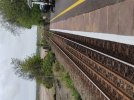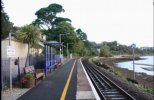Hi all, Track engineer here!
The holes in the sleepers are indeed specific fastening locations for guard rails. Steel sleepers are normally supplied without these holes but they can be ordered with them where it's inteneded to fit guard rails.
To mostly echo what others have said, rails in the 4ft like these are commonly used for either derailment protection (to constrain the trajectory of a derailed train, not prevent it derailing in the first place) and/or stiffness enhancement.
I don't know the site but from aerial mapping and can see no specific reason why the risks of derailment here are high enough to warrent guard rails, and thus assume they are purely for the latter. This would be supported by the omission of 'gathering' or 'butterfly' rails at the ends fo the guard rails. If they were there to mitigate derailments there would nortmally be a set of splayed rails at the start to 'catch' a derailed train and bring it back to a controlled position.
The track here appears to be (from a LIDAR survey) approx 1.5-2m above high tide level, so the formation will almost certainly be affected by changes in groundwater levels with the tides. Whilst I have no direct experiance with this site, I know of track monitoring in some places near the sea which has given results of around a 10mm difference in track level between high and low tides. Sounds bad but as it's gradual and uniform and it's the whole formation that's lifting and settling it's not really a big issue.
The formation here is likely to be quite soft and thus have a low stiffness value, which could present issues with differential settlement and poor vertical alignment, or 'top'. Overall track stiffness as experianced by a train is a result of many factors, one of which is the stiffness of the rail itself and one of which is the ability of the sleepers to distribute the load.
I note that this track had timber sleepers before the renewal, without these additional rails. Timbers weigh more than steels and also offer a small amount of compressability or 'give', contributing to improved track performance. Their replacement with steel meant the sleeper weight went down and this flexibility was lost, and also that the ability of the sleepers to spread the load to the ballast was reduced, increasing the point loading on the ballast and increasing the potential for settlement.
Adding the central two rails increses the stiffness of the track, mitigating this loss, and also meaning any localised settlement will have a lesser effect as the track is better able to 'span' any small areas with lesser load support.
With soft formation and low track stiffness you also have to be careful of something called a "Rayleigh wave" which can develop if the train is travelling at or near the "Critical Velocity" of the ground. This effect is dependant on the stiffness of the track and formation and the speed of the trains, and can cause derailments in a worst case scenario.
If you want to understand more about track stiffness etc I'd recommend this brilliant (says the track geek) read, which goes into it in good detail and explains it a lot better than I ever could:
https://www.thepwi.org/technical_hub/technical_hub_files/a_guide_to_track_stiffness_final_reviewr11
Another additional benefit is that the additional rails also provide an increase in lateral resistance, meaning that horizontal alignment is generally improved, the track has greater ability to resist thermal and dynamic forces and thus buckling, and if needed it has the potential for a slightly higher 'Critical Rail Temperature' to be applied (although this is not specified in standards and would have to be done via local agreements with the maintainer).
Definitely guard rails, as usually found on bridges. As for the AWS, there is a yellow magnet visible on Google Earth aerial photos, and in that first image I think it's hiding in the vegetation between the rails. The cancelling indicator method of dealing with AWS on branch lines allows an unsuppressed permanent magnet only to be used, which has no power or control cabling requirements. On low speed branches, spacing between a magnet and the board(s) or signals it applies to may be significantly less than the default circa 200m dimension used on main lines. Standards allow the dimension to be adjusted within consistent timing constraints where this is expedient.
I doubt there is bonding as there is unlikely to be any track circuits that far out of St Erth. The line is worked under authority of a train staff, and being diesel operated there's no need for any traction return bonding. Sometimes branches and sticks on the track can look a bit like bonding cables.
FYI the AWS magnet is just visible on aerial mapping here:
https://goo.gl/maps/S5dfjMuDAPQCE9GS9
As for bonding, I can't see any bonding in the photos and can't see any need for bonding of the guard rail. They would be bonded in an electrified area, but this clearly isn't one, so probably just branches or something giving an optical illusion.


